NDVI Indicates Long-Term Dynamics of Vegetation and Its Driving Forces from Climatic and Anthropogenic Factors in Mongolian Plateau
Abstract
1. Introduction
2. Materials and Methods
2.1. Study Area
2.2. Data Sources
2.2.1. The GIMMS NDVI3g V1.0 Dataset
2.2.2. CCI-LC Products
2.2.3. Climate Dataset
2.2.4. Socioeconomic Dataset
2.3. Methods
2.3.1. Linear Regression Method
2.3.2. Breaks for Additive Season and Trend (BFAST) Method
2.3.3. Partial Correlation Analysis Method
2.3.4. Geographical Detector Model
2.3.5. Residual Trends (RESTREND) Method
2.3.6. Stepwise Multiple Regression Model
3. Results
3.1. Long-term Changes in Different Climatic Factors
3.2. Abrupt Changes in Vegetation Dynamics
3.3. Vegetation Responses to Climate Change
3.3.1. Vegetation Responses to Interannual Climate Change during the Growing Season
3.3.2. Spatial Patterns of the Cumulative Effects of Climate Change on NDVI
3.4. Vegetation Responses to Anthropogenic Factors
3.5. Vegetation Responses to the Combined Effects of Climate Change and Anthropogenic Factors
4. Discussion
5. Conclusions
- For the entire Mongolian Plateau, there was a statistically significant increase in the PRE and SM at a rate of −10.48 and −1.19 mm/decade during the growing season, respectively. The mean temperature was observed to increase at a greater rate than that of worldwide global warming, resulting in a significant increase in PET at a rate of 2.99 mm/decade. The Tem of all pixels showed a significant increasing trend, while the PRE in 89.56 % of the study area showed a decreasing trend.
- There was significant spatial heterogeneity in changes to the NDVI for various vegetation types in the Mongolian Plateau. We found a fluctuation in the NDVI and an overall increasing trend from 1982–2015, with the except for broadleaf forests.
- At the pixel scale, BFAST detected trend variations showed that the total number of one or more BPs accounted for 71.34% of pixels, and 1993, 2003, and 2010 were the predominant years in which abrupt NDVI changes occurred on the Mongolian Plateau.
- All six climate factors (PRE, PET, SM, Tem, Tmax, and Tmin) had a significant influence on interannual NDVIgs variations, with large spatio-temporal heterogeneities. The interaction between climatic factors followed a bi-variable enhancement pattern. Moreover, PRE was the main climatic factor that positively influenced change in NDVIgs, accounting for 75.01% of the region, while the dominant mean NDVIgs change pattern was negatively correlated with PET, accounting for 55.97% of the area. The cumulative effects of climatic factors varied in terms of their influence on vegetation change.
- The results of the RESTREND method showed that 81.21% of the vegetation was positively influenced by anthropogenic activity on the Mongolian Plateau. However, there were multiple driving factors for vegetation changes in different regions. Specifically, the rapid economic growth (GDP), PRE, and SM were the key factors in IMG, while in Mongolia, PRE was the main climatic factor, while population and livestock were the key anthropogenic factors.
Supplementary Materials
Author Contributions
Funding
Institutional Review Board Statement
Informed Consent Statement
Data Availability Statement
Acknowledgments
Conflicts of Interest
References
- Piedallu, C.; Cheret, V.; Denux, J.P.; Perez, V.; Azcona, J.S.; Seynave, I.; Gegout, J.C. Soil and climate differently impact NDVI patterns according to the season and the stand type. Sci. Total Environ. 2019, 651, 2874–2885. [Google Scholar] [CrossRef]
- Cao, R.; Chen, Y.; Shen, M.; Chen, J.; Zhou, J.; Wang, C.; Yang, W. A simple method to improve the quality of NDVI time-series data by integrating spatiotemporal information with the Savitzky-Golay filter. Remote Sens. Environ. 2018, 217, 244–257. [Google Scholar] [CrossRef]
- Fang, H.; Baret, F.; Plummer, S.; Schaepman Strub, G. An Overview of Global Leaf Area Index (LAI): Methods, Products, Validation, and Applications. Rev. Geophys. 2019, 57, 739–799. [Google Scholar] [CrossRef]
- Zhang, Z.; Zhang, Y.; Zhang, Y.; Gobron, N.; Frankenberg, C.; Wang, S.; Li, Z. The potential of satellite FPAR product for GPP estimation: An indirect evaluation using solar-induced chlorophyll fluorescence. Remote Sens. Environ. 2020, 240, 111686. [Google Scholar] [CrossRef]
- Zewdie, W.; Csaplovics, E.; Inostroza, L. Monitoring ecosystem dynamics in northwestern Ethiopia using NDVI and climate variables to assess long term trends in dryland vegetation variability. Appl. Geogr. 2017, 79, 167–178. [Google Scholar] [CrossRef]
- Ye, W.T.; van Dijk, A.I.J.M.; Huete, A.; Yebra, M. Global trends in vegetation seasonality in the GIMMS NDVI3g and their robustness. Int. J. Appl. Earth Obs. Geoinf. 2021, 94, 102238. [Google Scholar] [CrossRef]
- Sun, R.; Chen, S.H.; Su, H.B. Climate Dynamics of the Spatiotemporal Changes of Vegetation NDVI in Northern China from 1982 to 2015. Remote Sens. 2021, 13, 187. [Google Scholar] [CrossRef]
- Li, J.; Fan, K.; Xu, J.; Powell, A.M.; Kogan, F. The effect of preceding wintertime Arctic polar vortex on springtime NDVI patterns in boreal Eurasia, 1982–2015. Clim. Dyn. 2017, 49, 23–35. [Google Scholar] [CrossRef]
- Chen, T.; de Jeu, R.A.M.; Liu, Y.Y.; van der Werf, G.R.; Dolman, A.J. Using satellite based soil moisture to quantify the water driven variability in NDVI: A case study over mainland Australia. Remote Sens. Environ. 2014, 140, 330–338. [Google Scholar] [CrossRef]
- Jamali, S.; Seaquist, J.; Eklundh, L.; Ardö, J. Automated mapping of vegetation trends with polynomials using NDVI imagery over the Sahel. Remote Sens. Environ. 2014, 141, 79–89. [Google Scholar] [CrossRef]
- Xu, X.; Liu, H.; Lin, Z.; Jiao, F.; Gong, H. Relationship of Abrupt Vegetation Change to Climate Change and Ecological Engineering with Multi-Timescale Analysis in the Karst Region, Southwest China. Remote Sens. 2019, 11, 1564. [Google Scholar] [CrossRef]
- Militino, A.F.; Moradi, M.; Ugarte, M.D. On the Performances of Trend and Change-Point Detection Methods for Remote Sensing Data. Remote Sens. 2020, 12, 1008. [Google Scholar] [CrossRef]
- Zhang, P.P.; Cai, Y.P.; Yang, W.; Yi, Y.Y.; Yang, Z.F.; Fu, Q. Contributions of climatic and anthropogenic drivers to vegetation dynamics indicated by NDVI in a large dam-reservoir-river system. J. Cleaner Prod. 2020, 256, 120477. [Google Scholar] [CrossRef]
- Wen, Z.F.; Wu, S.J.; Chen, J.L.; Lü, M.Q. NDVI indicated long-term interannual changes in vegetation activities and their responses to climatic and anthropogenic factors in the Three Gorges Reservoir Region, China. Sci. Total Environ. 2017, 574, 947–959. [Google Scholar] [CrossRef]
- Han, D.; Gao, C.; Liu, H.; Yu, X.; Li, Y.; Cong, J.; Wang, G. Vegetation dynamics and its response to climate change during the past 2000 years along the Amur River Basin, Northeast China. Ecol. Indic. 2020, 117, 106577. [Google Scholar] [CrossRef]
- Kern, A.; Marjanović, H.; Barcza, Z. Spring vegetation green-up dynamics in Central Europe based on 20-year long MODIS NDVI data. Agr. Forest Meteorol. 2020, 287, 107969. [Google Scholar] [CrossRef]
- Linscheid, N.; Estupinan-Suarez, L.M.; Brenning, A.; Carvalhais, N.; Cremer, F.; Gans, F.; Rammig, A.; Reichstein, M.; Sierra, C.A.; Mahecha, M.D. Towards a global understanding of vegetation–climate dynamics at multiple timescales. Biogeosciences 2020, 17, 945–962. [Google Scholar] [CrossRef]
- Peng, W.; Kuang, T.; Tao, S. Quantifying influences of natural factors on vegetation NDVI changes based on geographical detector in Sichuan, western China. J. Clean. Prod. 2019, 233, 353–367. [Google Scholar] [CrossRef]
- Zhou, X.; Yamaguchi, Y.; Arjasakusuma, S. Distinguishing the vegetation dynamics induced by anthropogenic factors using vegetation optical depth and AVHRR NDVI: A cross-border study on the Mongolian Plateau. Sci. Total Environ. 2018, 616, 730–743. [Google Scholar] [CrossRef]
- Gang, C.; Wei, Z.; Chen, Y.; Wang, Z.; Sun, Z.; Li, J.; Qi, J.; Odeh, I. Quantitative assessment of the contributions of climate change and human activities on global grassland degradation. Environ. Earth Sci. 2014, 72, 4273–4282. [Google Scholar] [CrossRef]
- Zhang, Y.; Wang, Q.; Wang, Z.; Yang, Y.; Li, J. Impact of human activities and climate change on the grassland dynamics under different regime policies in the Mongolian Plateau. Sci. Total Environ. 2020, 698, 134304. [Google Scholar] [CrossRef]
- Fan, D.; Ni, L.; Jiang, X.; Fang, S.; Wu, H.; Zhang, X. Spatiotemporal Analysis of Vegetation Changes along the Belt and Road Initiative Region from 1982 to 2015. IEEE Access 2020, 8, 122579–122588. [Google Scholar] [CrossRef]
- Ying, H.; Zhang, H.; Zhao, J.; Shan, Y.; Zhang, Z.; Guo, X.; Rihan, W.; Deng, G. Effects of spring and summer extreme climate events on the autumn phenology of different vegetation types of Inner Mongolia, China, from 1982 to 2015. Ecolo. Indic. 2020, 111, 105974. [Google Scholar] [CrossRef]
- Bao, G.; Chen, J.; Chopping, M.; Bao, Y.; Bayarsaikhan, S.; Dorjsuren, A.; Tuya, A.; Jirigala, B.; Qin, Z. Dynamics of net primary productivity on the Mongolian Plateau: Joint regulations of phenology and drought. Int. J. Appl. Earth Obs. 2019, 81, 85–97. [Google Scholar] [CrossRef]
- Jin, H.; Bao, G.; Chen, J.; Chopping, M.; Jin, E.; Mandakh, U.; Jiang, K.; Huang, X.; Bao, Y.; Vandansambuu, B. Modifying the maximal light-use efficiency for enhancing predictions of vegetation net primary productivity on the Mongolian Plateau. Int. J. Remote Sens. 2019, 41, 3740–3760. [Google Scholar] [CrossRef]
- Bao, G.; Bao, Y.; Sanjjava, A.; Qin, Z.; Zhou, Y.; Xu, G. NDVI-indicated long-term vegetation dynamics in Mongolia and their response to climate change at biome scale. Int. J. Climatol. 2015, 35, 4293–4306. [Google Scholar] [CrossRef]
- Rogers, A.; Medlyn, B.E.; Dukes, J.S. A roadmap for improving the representation of photosynthesis in Earth system models. New Phytol. 2017, 213, 22–42. [Google Scholar] [CrossRef] [PubMed]
- Kottek, M.; Grieser, J.; Beck, C.; Rudolf, B.; Rubel, F. World map of the Köppen-Geiger climate classification updated. Meteorol. Z. 2006, 15, 259–263. [Google Scholar] [CrossRef]
- Dong, G.; Zhao, F.Y.; Chen, J.Y.; Zhang, Y.; Qu, L.P.; Jiang, S.C.; Ochirbat, B.; Chen, J.Y.; Xin, X.P.; Shao, C.L. Non-climatic component provoked substantial spatiotemporal changes of carbon and water use efficiency on the Mongolian Plateau. Environ. Res. Lett. 2020, 15, 095009. [Google Scholar] [CrossRef]
- Tong, S.; Zhang, J.; Ha, S.; Lai, Q.; Ma, Q. Dynamics of Fractional Vegetation Coverage and Its Relationship with Climate and Human Activities in Inner Mongolia, China. Remote Sens. 2016, 8, 776. [Google Scholar] [CrossRef]
- Bao, G.; Bao, Y.; Qin, Z.; Xin, X.; Bao, Y.; Bayarsaikan, S.; Zhou, Y.; Chuntai, B. Modeling net primary productivity of terrestrial ecosystems in the semi-arid climate of the Mongolian Plateau using LSWI-based CASA ecosystem model. Int. J. Appl. Earth Obs. 2016, 46, 84–93. [Google Scholar] [CrossRef]
- Pinzon, J.E. A Non-Stationary 1981-2015 AVHRR NDVI 3g Time Series. In Proceedings of the AGU Fall Meeting, San Francisco, CA, USA, 14–18 December 2015. [Google Scholar]
- Abatzoglou, J.T.; Dobrowski, S.Z.; Parks, S.A.; Hegewisch, K.C. TerraClimate, a high-resolution global dataset of monthly climate and climatic water balance from 1958–2015. Sci. Data 2018, 5, 170191. [Google Scholar] [CrossRef] [PubMed]
- Liu, Z.; Wu, C.; Liu, Y.; Wang, X.; Fang, B.; Yuan, W.; Ge, Q. Spring green-up date derived from GIMMS3g and SPOT-VGT NDVI of winter wheat cropland in the North China Plain. ISPRS J. Photogramm. 2017, 130, 81–91. [Google Scholar] [CrossRef]
- Verbesselt, J.; Hyndman, R.; Newnham, G.; Culvenor, D. Detecting trend and seasonal changes in satellite image time series. Remote Sens. Environ. 2010, 114, 106–115. [Google Scholar] [CrossRef]
- Wang, Y.; Liu, G.; Guo, E. Spatial distribution and temporal variation of drought in Inner Mongolia during 1901–2014 using Standardized Precipitation Evapotranspiration Index. Sci. Total Environ. 2019, 654, 850–862. [Google Scholar] [CrossRef]
- Song, Y.Z.; Wang, J.F.; Ge, Y.; Xu, C.D. An optimal parameters-based geographical detector model enhances geographic characteristics of explanatory variables for spatial heterogeneity analysis: Cases with different types of spatial data. Gisci. Remote Sens. 2020, 57, 593–610. [Google Scholar] [CrossRef]
- Wang, J.F.; Li, X.H.; Christakos, G.; Liao, Y.L.; Zhang, T.; Gu, X.; Zheng, X.Y. Geographical Detectors-Based Health Risk Assessment and its Application in the Neural Tube Defects Study of the Heshun Region, China. Int. J. Geogr. Inf. Sci 2010, 24, 107–127. [Google Scholar] [CrossRef]
- Evans, J.; Geerken, R. Discrimination between climate and human-induced dryland degradation. J. Arid Environ. 2014, 57, 535–554. [Google Scholar] [CrossRef]
- Chu, H.; Venevsky, S.; Wu, C.; Wang, M. NDVI-based vegetation dynamics and its response to climate changes at Amur-Heilongjiang River Basin from 1982 to 2015. Sci. Total Environ. 2019, 650, 2051–2062. [Google Scholar] [CrossRef] [PubMed]
- Groemping, U. Relative Importance for linear regression in R: The package relaimpo. J. Statal. Softw. 2016, 17, 925–933. [Google Scholar]
- Yin, L.; Feng, X.; Fu, B.; Chen, Y.; Wang, X.; Tao, F. Irrigation water consumption of irrigated cropland and its dominant factor in China from 1982 to 2015. Adv. Water Resour. 2020, 143, 103661. [Google Scholar] [CrossRef]
- NOAA. State of the Climate: Global Climate Report for January 2019, Published Online February 2019. Available online: https://www.ncdc.noaa.gov/sotc/global/201901 (accessed on 26 September 2020).
- Allington, G.R.H.; Li, W.; Brown, D.G. Urbanization and environmental policy effects on the future availability of grazing resources on the Mongolian Plateau: Modeling socio-environmental system dynamics. Environ. Sci. Policy 2017, 68, 35–46. [Google Scholar] [CrossRef]
- Rihan, W.; Zhao, J.; Zhang, H.; Guo, X.; Ying, H.; Deng, G.; Li, H. Wildfires on the Mongolian Plateau: Identifying Drivers and Spatial Distributions to Predict Wildfire Probability. Remote Sens. 2019, 11, 2361. [Google Scholar] [CrossRef]
- Qiu, B.; Chen, G.; Tang, Z.; Lu, D.; Wang, Z.; Chen, C. Assessing the Three-North Shelter Forest Program in China by a novel framework for characterizing vegetation changes. ISPRS J. Photogramm. 2017, 133, 75–88. [Google Scholar] [CrossRef]
- Guo, L.; Wu, S.; Zhao, D.; Yin, Y.; Leng, G.; Zhang, Q. NDVI-based vegetation change in Inner Mongolia from 1982 to 2006 and its relationship to climate at the biome scale. Adv. Meteorol. 2014, 2014, 1–12. [Google Scholar] [CrossRef]
- Fang, J.; Piao, S.; Zhou, L.; He, J.; Wei, F.; Myneni, R.B.; Tucker, C.J.; Tan, K. Precipitation patterns alter growth of temperate vegetation. Geophys. Res. Lett. 2005, 32, L21411. [Google Scholar] [CrossRef]
- Piao, S.; Mohammat, A.; Fang, J.; Cai, Q.; Feng, J. NDVI-based increase in growth of temperate grasslands and its responses to climate changes in China. Global Environ. Chang. 2006, 16, 340–348. [Google Scholar] [CrossRef]
- Asam, S.; Callegari, M.; Matiu, M.; Fiore, G.; De Gregorio, L.; Jacob, A.; Menzel, A.; Zebisch, M.; Notarnicola, C. Relationship between Spatiotemporal Variations of Climate, Snow Cover and Plant Phenology over the Alps—An Earth Observation-Based Analysis. Remote Sens. 2018, 10, 1757. [Google Scholar] [CrossRef]
- Liu, L.; Gudmundsson, L.; Hauser, M.; Qin, D.; Li, S.; Seneviratne, S.I. Soil moisture dominates dryness stress on ecosystem production globally. Nat. Commun. 2020, 11, 1–9. [Google Scholar]
- Camps, A.; Park, H.; Pablos, M.; Foti, G.; Gommenginger, C.P.; Liu, P.W.; Judge, J. Sensitivity of GNSS-R spaceborne observations to soil moisture and vegetation. IEEE J-STARS 2016, 9, 4730–4742. [Google Scholar] [CrossRef]
- Bradford, J.B.; Schlaepfer, D.R.; Lauenroth, W.K.; Palmquist, K.A. Robust ecological drought projections for drylands in the 21st century. Glob. Chang. Biol. 2020, 26, 3906–3919. [Google Scholar] [CrossRef]
- Zhang, P.; Jeong, J.h.; Yoon, J.H.; Kim, H.; Wang, S.Y.; Linderholm, H.W.; Fang, K.Y.; Wu, X.C.; Chen, D.L. Abrupt shift to hotter and drier climate over inner East Asia beyond the tipping point. Science 2020, 370, 1095–1099. [Google Scholar] [CrossRef] [PubMed]
- Piao, S.; Cui, M.; Chen, A.; Wang, X.; Ciais, P.; Liu, J.; Tang, Y. Altitude and temperature dependence of change in the spring vegetation green-up date from 1982 to 2006 in the Qinghai-Xizang Plateau. Agr. For. Meteorol. 2011, 151, 1599–1608. [Google Scholar] [CrossRef]
- Yu, Z.; Li, Z.; Rasmus, F.; Kun, W.; Irina, V.; Feng, T. Climate contributions to vegetation variations in central Asian drylands: Pre- and Post-Ussr collapse. Remote Sens. 2015, 7, 2449–2470. [Google Scholar]
- Zhou, Z.; Ding, Y.; Shi, H.; Cai, H.; Li, T. Analysis and prediction of vegetation dynamic changes in china: Past, present and future. Ecolo. Indic. 2012, 117, 106642. [Google Scholar] [CrossRef]
- Gradel, A.; Sukhbaatar, G.; Karthe, D.; Kang, H. Forest management in Mongolia—A review of challenges and lessons learned with special reference to degradation and deforestation. Geogr. Environ. Sustain. 2019, 12, 133–166. [Google Scholar] [CrossRef]
- Simonov, E.; Wickel, B. Kherlen River the Lifeline of the Eastern Steppe. Towards Integrated River Basin Management of the Dauria Steppe Transboundary River Basins by Rivers without Boundaries. 2016. Available online: http://www.transrivers.org/pdf/20150503Kherlen%20RiverReport.Pdf (accessed on 1 December 2020).
- Wei, Y.; Zhen, L. The dynamics of livestock and its influencing factors on the Mongolian Plateau. Environ. Dev. 2020, 34, 100518. [Google Scholar] [CrossRef]
- Tong, S.; Zhang, J.; Bao, Y.; Lai, Q.; Lian, X.; Li, N.; Bao, Y. Analyzing vegetation dynamic trend on the Mongolian Plateau based on the hurst exponent and influencing factors from 1982–2013. J. Geogr. Sci. 2018, 28, 595–610. [Google Scholar] [CrossRef]
- Gao, L.; Kinnucan, H.W.; Zhang, Y.; Qiao, G. The effects of a subsidy for grassland protection on livestock numbers, grazing intensity, and herders’ income in inner Mongolia. Land Use Policy 2016, 54, 302–312. [Google Scholar] [CrossRef]
- Yang, H. China’s Natural Forest Protection Program: Progress and impacts. For. Chron. 2017, 93, 113–117. [Google Scholar] [CrossRef][Green Version]
- Lee, D.; Ahn, G. A way forward to sustainable international forestry cooperation: A case study of the ‘greenbelt plantation project in Mongolia’. J. Rural Dev. Nongchon-Gyeongje 2016, 39, 1–26. [Google Scholar]
- Nandintsetseg, B.; Shinoda, M.; Erdenetsetseg, B. Contributions of multiple climate hazards and overgrazing to the 2009/2010 winter disaster in Mongolia. Nat. Hazards 2018, 92, 109–126. [Google Scholar] [CrossRef]
- Park, H.; Fan, P.; John, R.; Ouyang, Z.; Chen, J. Spatiotemporal changes of informal settlements: Ger districts in Ulaanbaatar, Mongolia. Landsc. Urban Plan. 2019, 191, 103630. [Google Scholar] [CrossRef]
- Zhao, X.; Hu, H.; Shen, H.; Zhou, D.; Fang, J. Satellite-indicated long-term vegetation changes and their drivers on the Mongolian Plateau. Landsc. Ecol. 2015, 30, 1599–1611. [Google Scholar] [CrossRef]
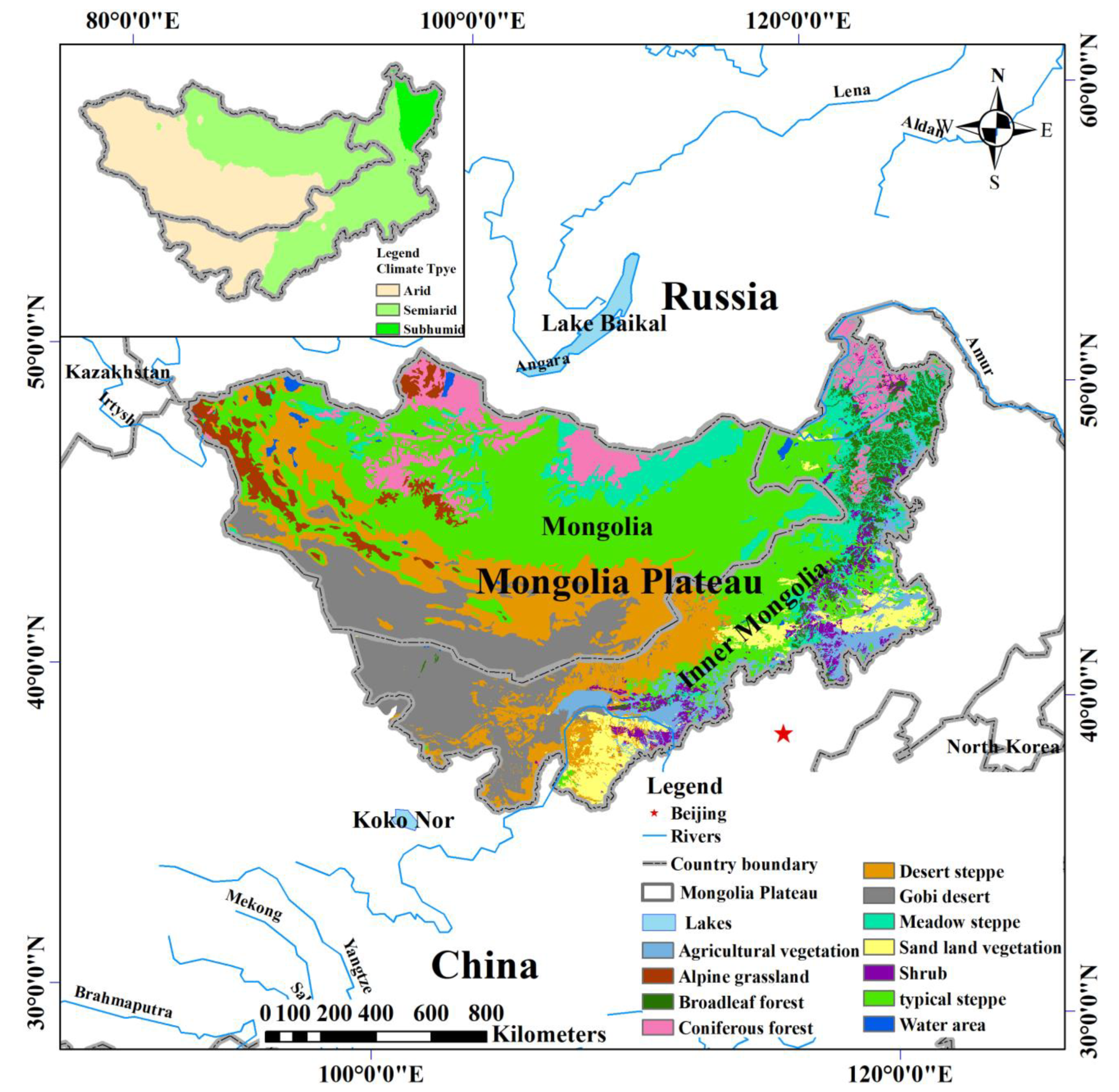
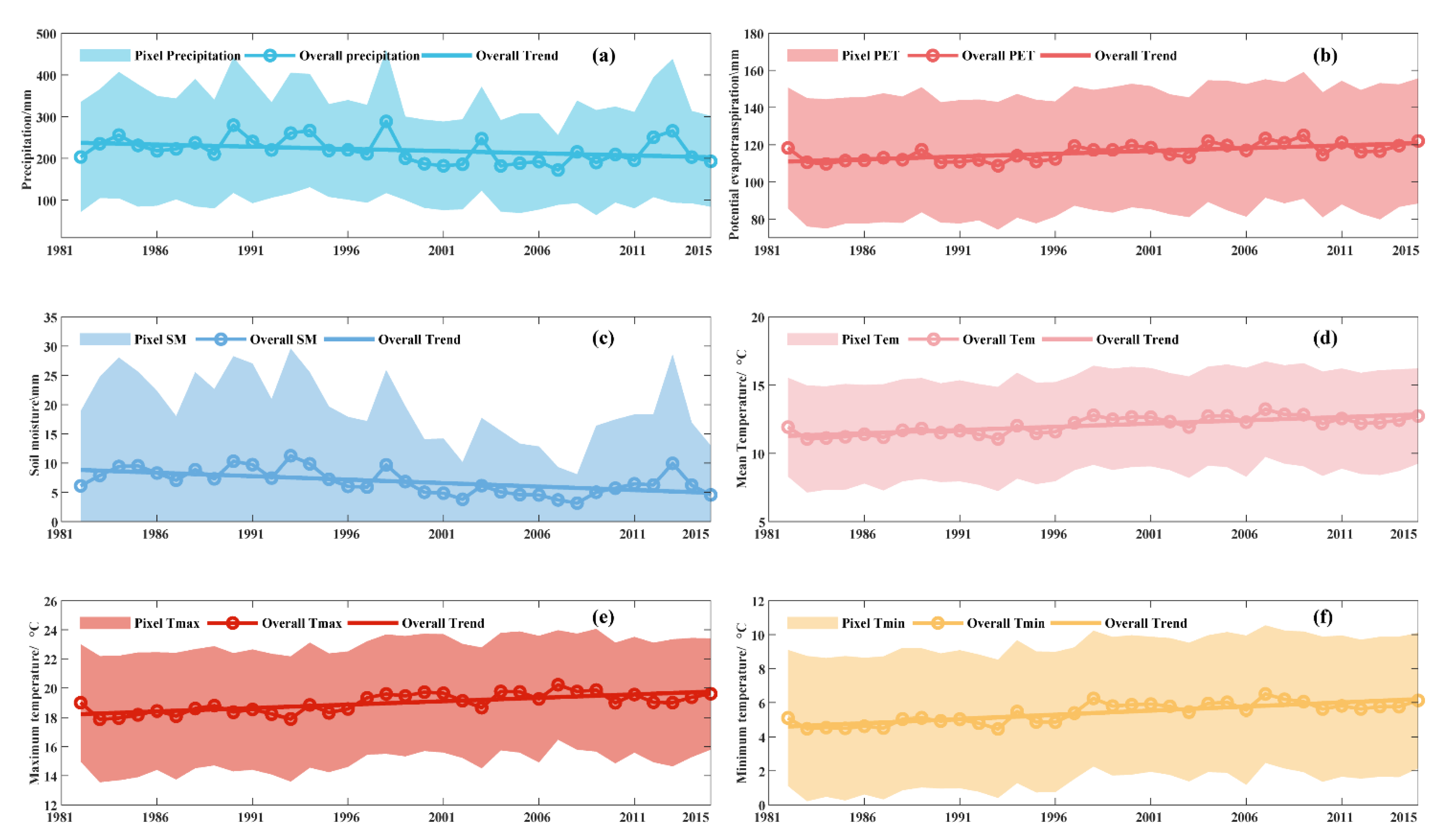
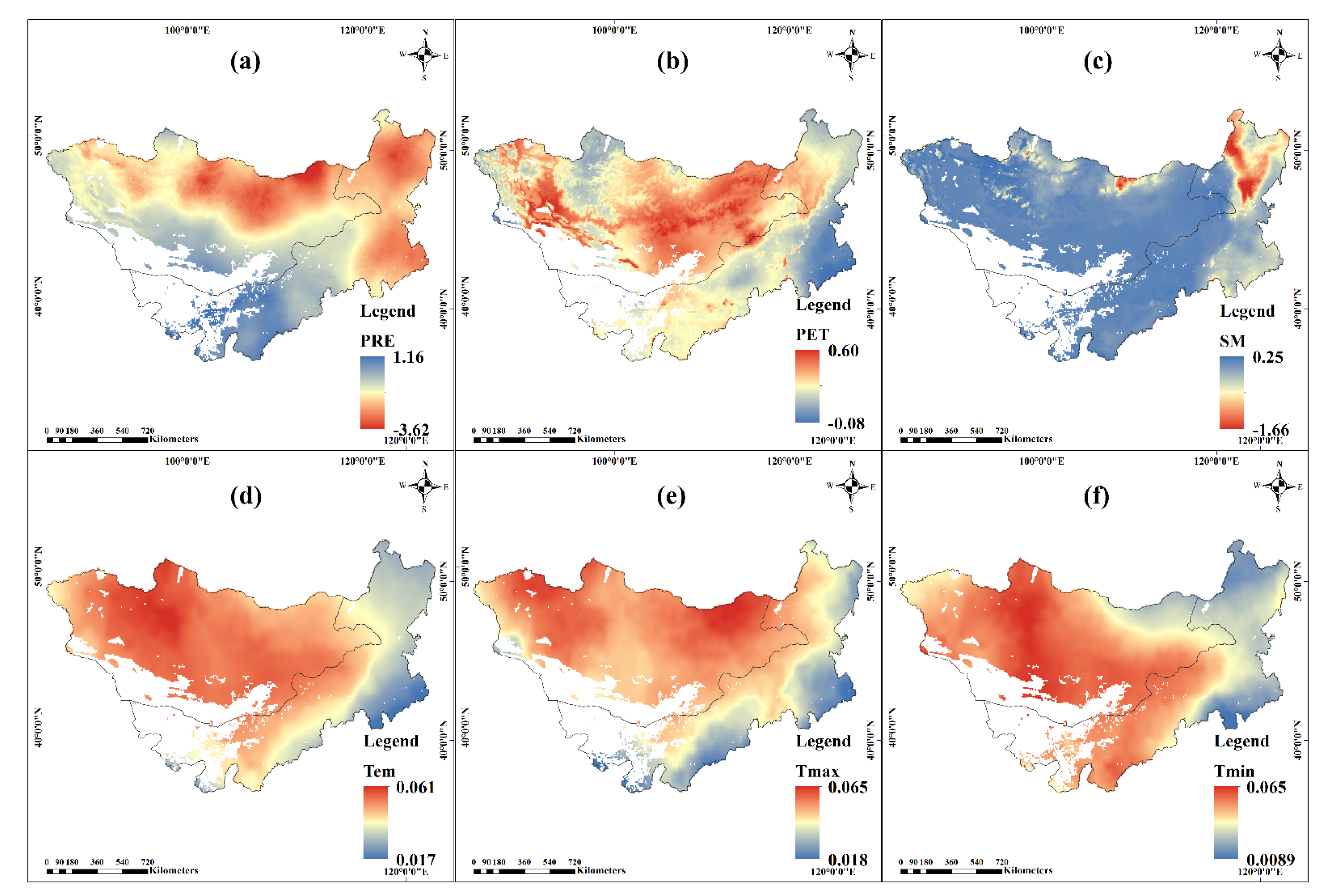





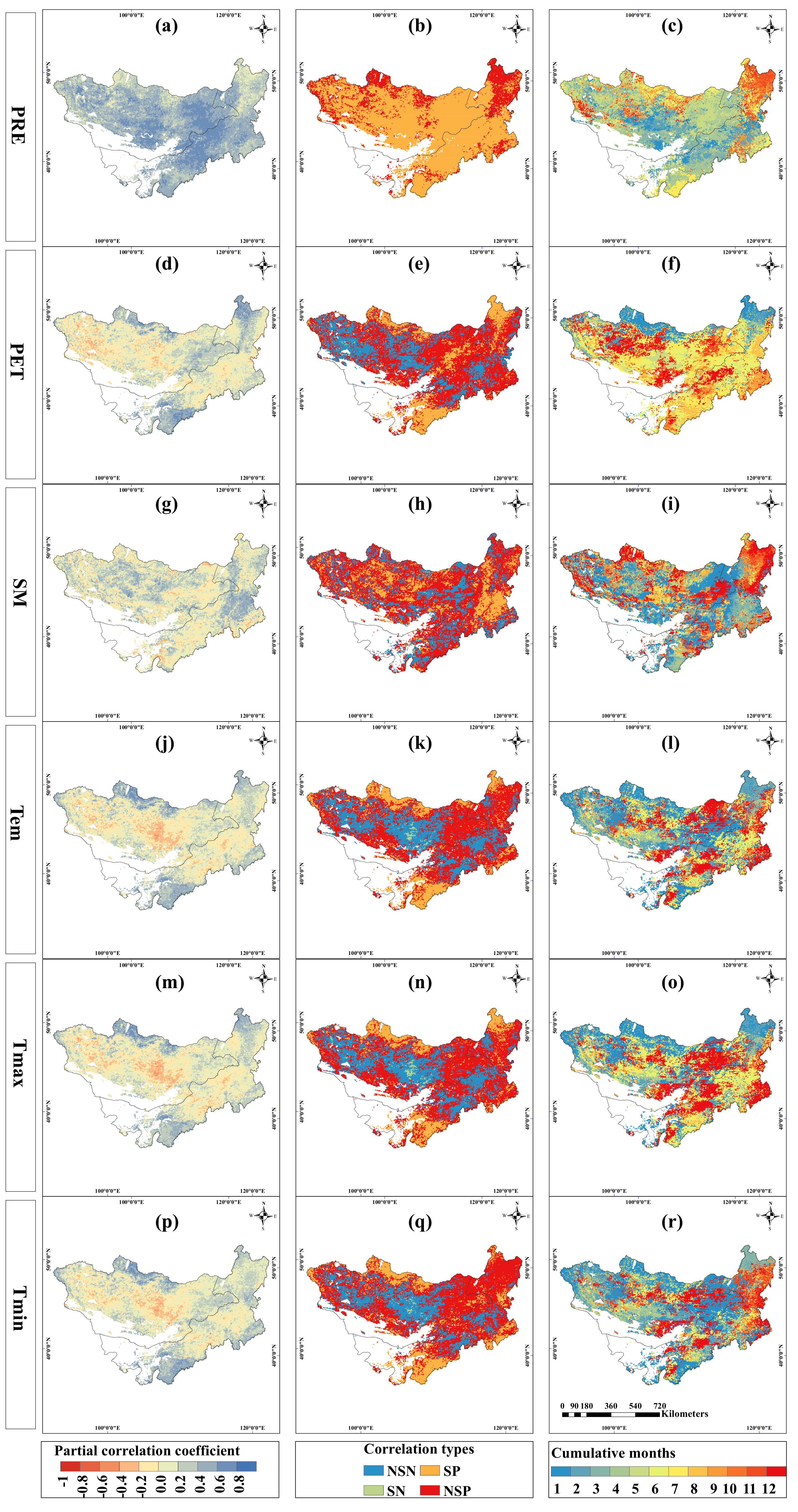
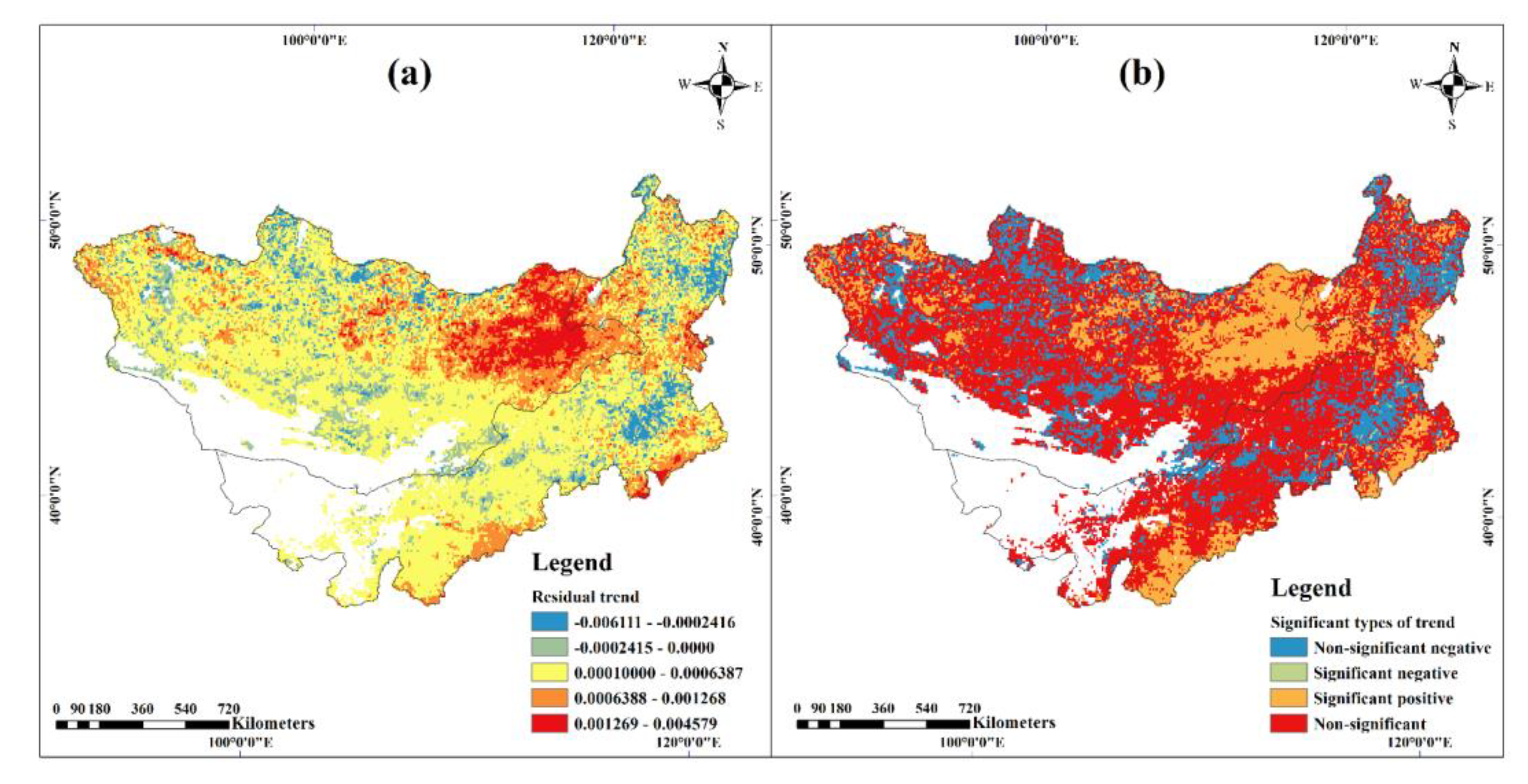
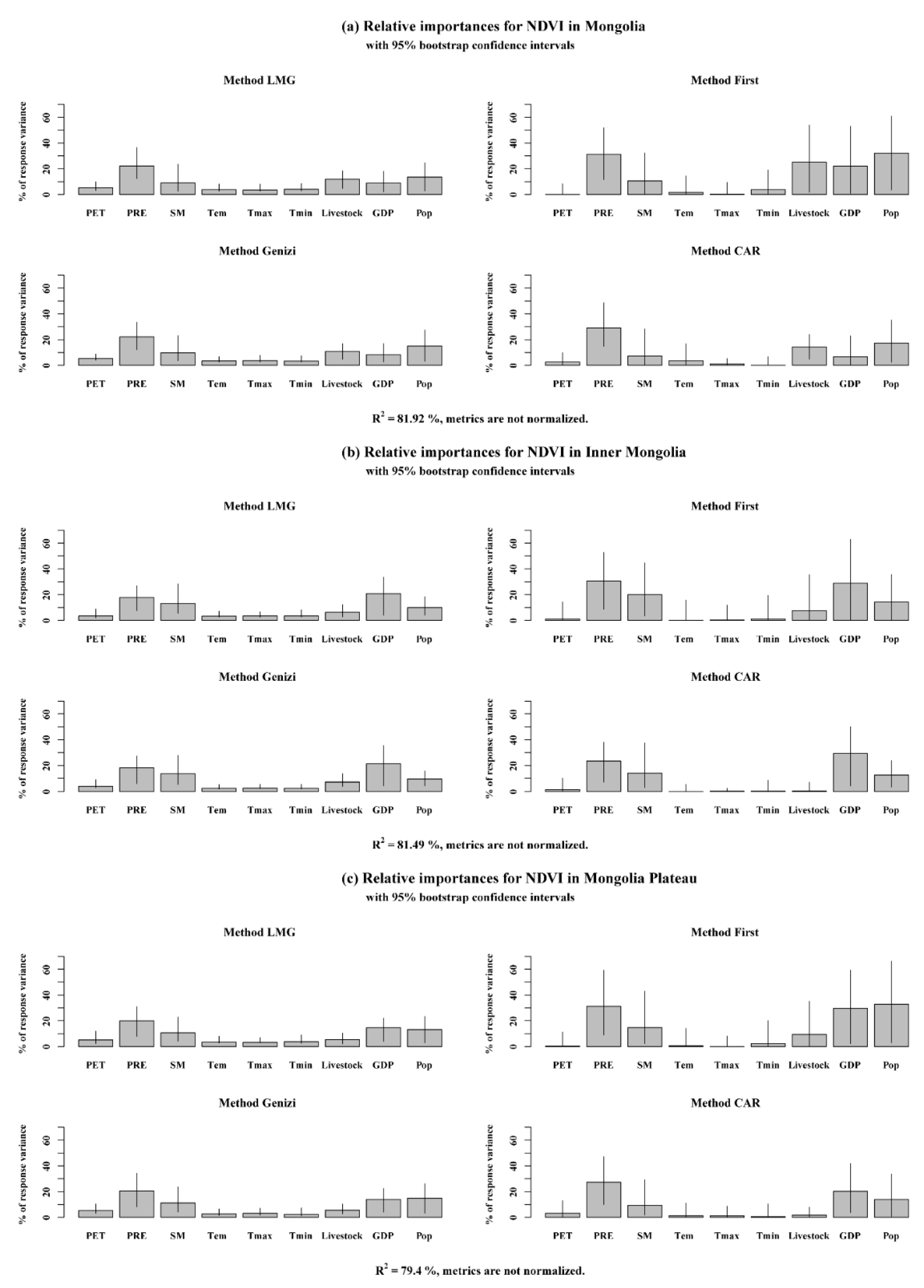
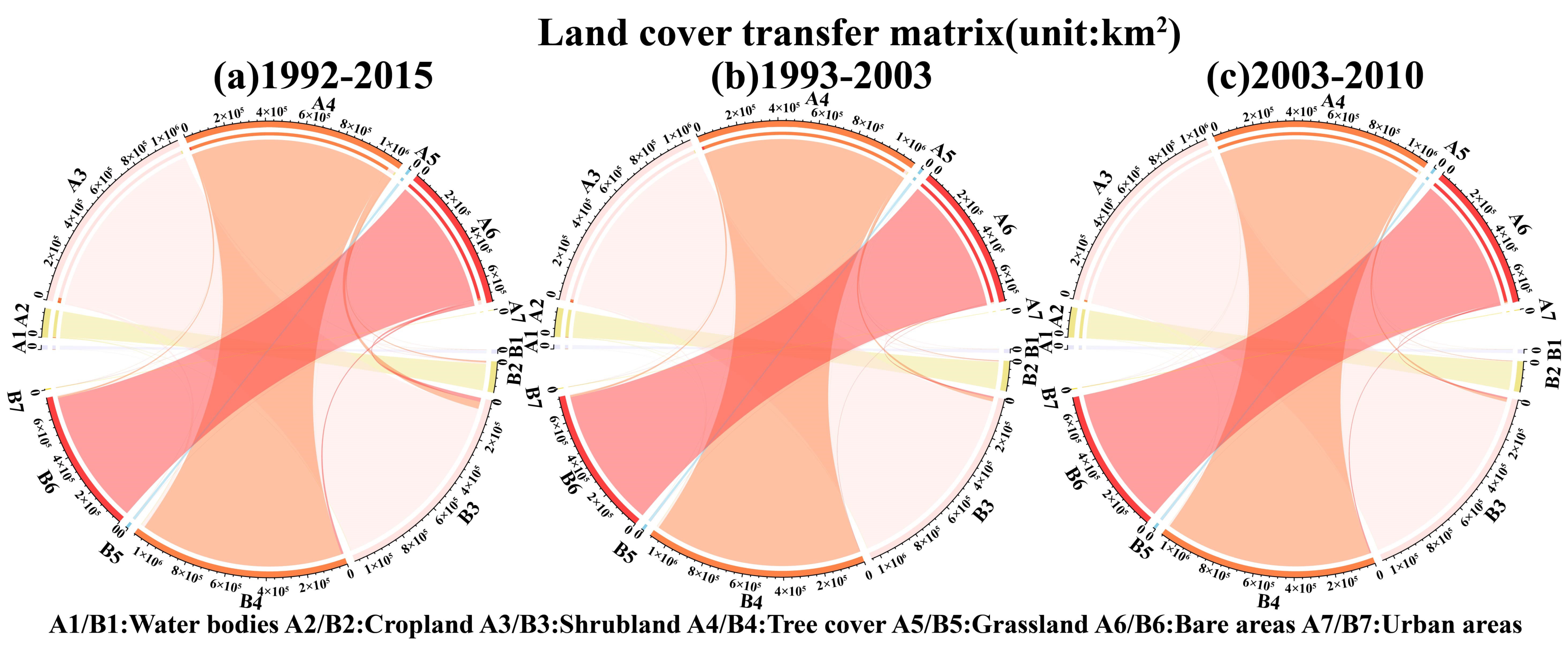
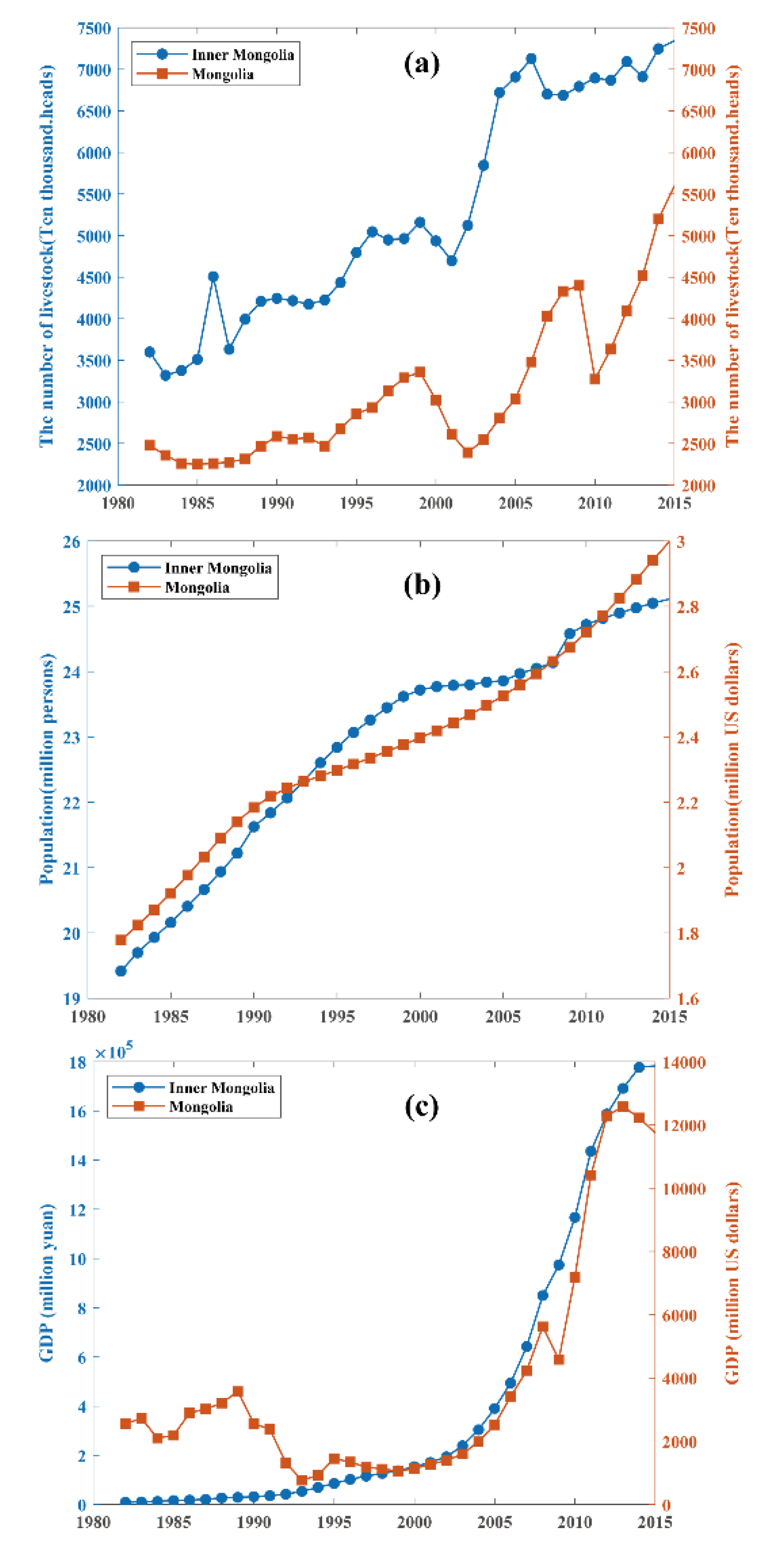
| Name | Time Scale | Spatial Scale | Data Sources |
|---|---|---|---|
| GIMMS NDVI3g V1.0 | 1982–2015 | 0.083° | NASA https://ecocast.arc.nasa.gov/data/pub/gimms/3g.v1/ (accessed on 23 December 2020) |
| CCI-LC products | 1992–2015 | 300 m | European Space Agency (ESA) Climate Change Initiative (CCI) http://www.esa.int/ (accessed on 23 December 2020) |
| Potential evapotranspiration (PET) | 1981–2015 | ~4-km (1/24°) | TerraClimate dataset http://www.climatologylab.org/terraclimate.html (accessed on 23 December 2020) |
| Precipitation (PRE) | |||
| Maximum temperature (Tmax) | |||
| Minimum temperature (Tmin) | |||
| Soil moisture (SM) | |||
| Mean temperature (Tem) | 0.5° | CRU4.04 (http://data.ceda.ac.uk/badc/cru/data/cru_ts/cru_ts_4.04/data (accessed on 23 December 2020)) | |
| The numbers of livestock | 1982–2015 | National | Inner Mongolia Statistical Yearbook (1982–2015)/ Mongolian Statistical Information Service |
| Human population (Pop) | |||
| Gross domestic product (GDP) |
| Types | 0 | 1 | 2 | 3 | 4 | 1 or More Breakpoints |
|---|---|---|---|---|---|---|
| Meadow steppe | 4.00 | 5.42 | 1.87 | 0.18 | 0.02 | 7.49 |
| Typical steppe | 9.85 | 16.64 | 10.00 | 2.39 | 0.35 | 29.38 |
| Alpine steppe | 1.71 | 1.11 | 0.70 | 0.36 | 0.04 | 2.21 |
| Shrub | 0.56 | 1.48 | 0.61 | 0.07 | 0.00 | 2.16 |
| Desert steppe | 5.83 | 5.04 | 5.98 | 2.41 | 0.40 | 13.82 |
| Broadleaf forest | 1.61 | 1.12 | 0.55 | 0.04 | 0.00 | 1.71 |
| Agricultural vegetation | 1.37 | 3.18 | 1.06 | 0.08 | 0.00 | 4.32 |
| Sand land vegetation | 1.08 | 2.82 | 0.45 | 0.04 | 0.00 | 3.31 |
| Coniferous forest | 4.41 | 3.15 | 1.88 | 0.12 | 0.02 | 5.17 |
| Total | 30.42 | 39.95 | 23.10 | 5.70 | 0.83 | 69.58 |
| Types | 0 | 1 | 2 | 3 | 4 | 1 or More Breakpoints |
|---|---|---|---|---|---|---|
| Meadow steppe | 34.84 | 47.13 | 16.27 | 1.58 | 0.18 | 65.16 |
| Typical steppe | 25.1 | 42.43 | 25.5 | 6.08 | 0.89 | 74.9 |
| Alpine steppe | 43.63 | 28.25 | 17.77 | 9.28 | 1.06 | 56.36 |
| Shrub | 20.53 | 54.35 | 22.54 | 2.58 | 0 | 79.47 |
| Desert steppe | 29.67 | 25.62 | 30.41 | 12.27 | 2.04 | 70.34 |
| Broadleaf forest | 48.59 | 33.65 | 16.59 | 1.17 | 0 | 51.41 |
| Agricultural vegetation | 24.04 | 55.94 | 18.56 | 1.46 | 0 | 75.96 |
| Sand land vegetation | 24.65 | 64.13 | 10.34 | 0.89 | 0 | 75.36 |
| Coniferous forest | 46.01 | 32.9 | 19.65 | 1.25 | 0.19 | 53.99 |
Publisher’s Note: MDPI stays neutral with regard to jurisdictional claims in published maps and institutional affiliations. |
© 2021 by the authors. Licensee MDPI, Basel, Switzerland. This article is an open access article distributed under the terms and conditions of the Creative Commons Attribution (CC BY) license (http://creativecommons.org/licenses/by/4.0/).
Share and Cite
Guo, E.; Wang, Y.; Wang, C.; Sun, Z.; Bao, Y.; Mandula, N.; Jirigala, B.; Bao, Y.; Li, H. NDVI Indicates Long-Term Dynamics of Vegetation and Its Driving Forces from Climatic and Anthropogenic Factors in Mongolian Plateau. Remote Sens. 2021, 13, 688. https://doi.org/10.3390/rs13040688
Guo E, Wang Y, Wang C, Sun Z, Bao Y, Mandula N, Jirigala B, Bao Y, Li H. NDVI Indicates Long-Term Dynamics of Vegetation and Its Driving Forces from Climatic and Anthropogenic Factors in Mongolian Plateau. Remote Sensing. 2021; 13(4):688. https://doi.org/10.3390/rs13040688
Chicago/Turabian StyleGuo, Enliang, Yongfang Wang, Cailin Wang, Zhongyi Sun, Yulong Bao, Naren Mandula, Buren Jirigala, Yuhai Bao, and He Li. 2021. "NDVI Indicates Long-Term Dynamics of Vegetation and Its Driving Forces from Climatic and Anthropogenic Factors in Mongolian Plateau" Remote Sensing 13, no. 4: 688. https://doi.org/10.3390/rs13040688
APA StyleGuo, E., Wang, Y., Wang, C., Sun, Z., Bao, Y., Mandula, N., Jirigala, B., Bao, Y., & Li, H. (2021). NDVI Indicates Long-Term Dynamics of Vegetation and Its Driving Forces from Climatic and Anthropogenic Factors in Mongolian Plateau. Remote Sensing, 13(4), 688. https://doi.org/10.3390/rs13040688










